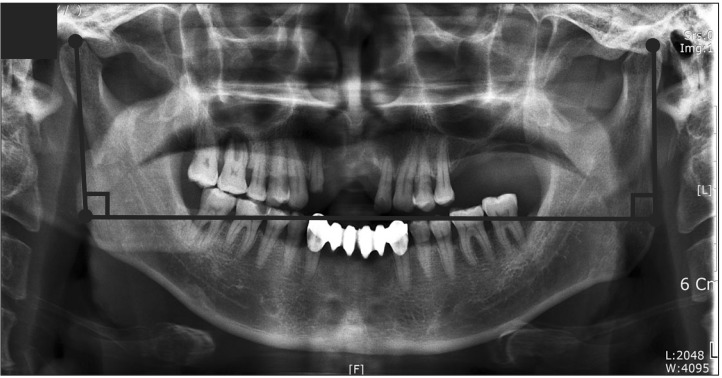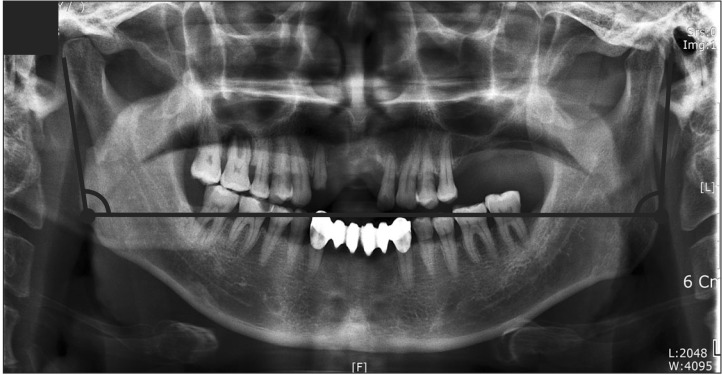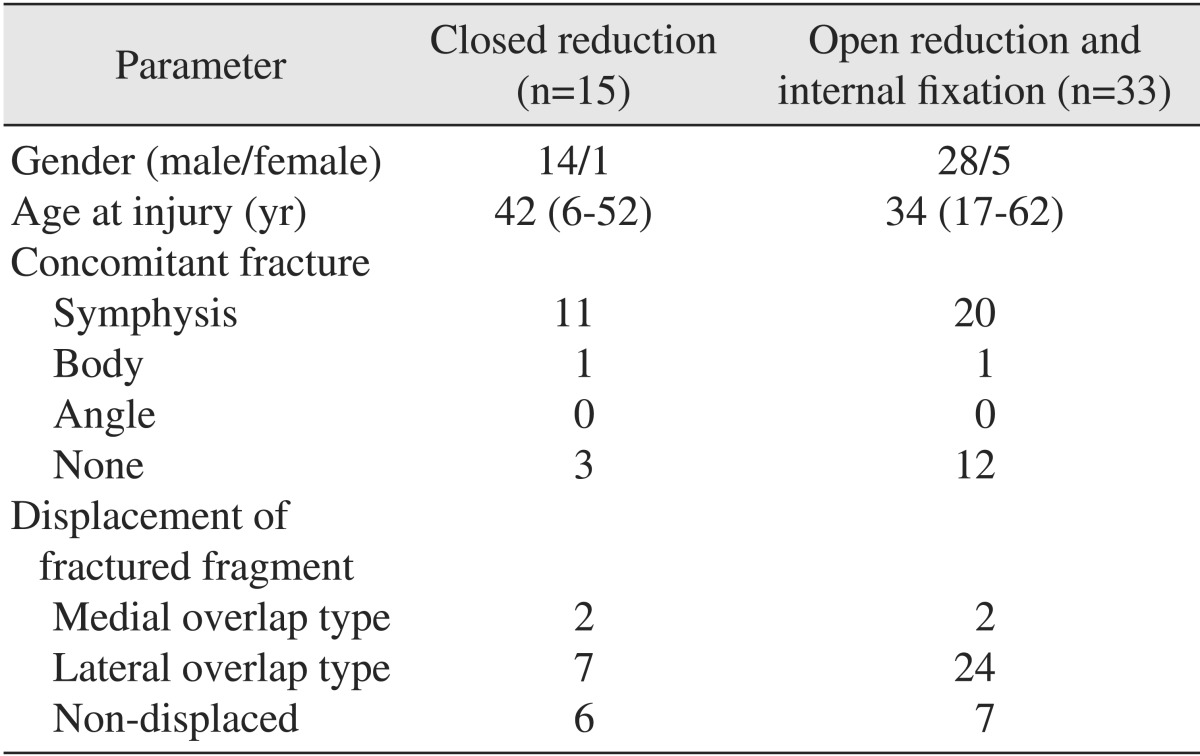This article has been
cited by other articles in ScienceCentral.
Abstract
Objectives
To compare the clinical and radiological outcomes after closed reduction (CR) and open reduction and internal fixation (ORIF) in the management of subcondylar fractures.
Materials and Methods
Forty-eight patients presenting with subcondylar fracture between January 2010 and March 2013 were evaluated retrospectively. Fifteen patients were treated with CR and 33 patients with ORIF. The clinical and radiologic parameters were evaluated during follow-up (mean, 7.06 months; range, 3 to 36 months).
Results
In the CR group, no patients had any problems with regard to the clinical parameters. The average period of maxillomandibular fixation (MMF) was 5.47 days. The preoperative average tangential angulation of the fractured fragment was 3.67°, and loss of ramus height was 2.44 mm. In the ORIF group, no clinical problems were observed, and the average period of MMF was 6.33 days. The preoperative average tangential angulation of the subcondylar fragment was 8.66°, and loss of ramus height was 3.61 mm.
Conclusion
CR provided satisfactory clinical results, though ORIF provided more accurate reduction of the fractured fragment. So there is no distinct displacement of fractured fragment, CR should be selected than ORIF because of no need for surgery.
Go to :

Keywords: Subcondylar fracture, Closed reduction, Open reduction and internal fixation
I. Introduction
The subcondylar area is the most common site of mandibular condylar fracture
1,
2. The treatment of subcondylar fractures can be divided into two major treatment methods: closed treatment or closed reduction (CR) and open reduction and internal fixation (ORIF). CR requires a period of maxillomandibular fixation (MMF), followed by active physiotherapy. ORIF allows good anatomical repositioning and immediate functional movement of the jaw. This study compares the clinical and radiological outcomes after CR and ORIF management of subcondylar fractures.
Go to :

II. Materials and Methods
Forty-eight patients presenting with subcondylar fracture between January 2010 and March 2013 at the Department of Oral and Maxillofacial Surgery, Gachon University Gil Medical Center were included in this retrospective study. The treatment methods were decided according to the surgeons' preferences and experiences. Fifteen patients (14 males and 1 female) with an age range of 6 to 52 years (mean, 42 years) were treated with CR, and 33 patients (28 males and 5 females) with an age range of 17 to 62 years (mean, 34 years) underwent an ORIF operation. Patients with CR were followed-up for an average of 10.7 months (range, 3 to 36 months). Those with ORIF were followed-up for an average of 3.8 months (range, 3 to 24 months). All patients included in this study had more than three months of follow-up. A telephone survey was performed for the 6 CR patients who did not visit the clinic for three months after the first visit.
Chart review was performed, and occlusion, maximal mouth opening, deviation on mouth opening, and nerve injury were evaluated. Radiologic assessment was also performed to evaluate the tangential angulation of the displaced fragment and loss of ramus height, as described in Palmieri et al.
3. The amount of condyle fragment displacement (tangential angulation and loss of ramus height) was evaluated on panoramic radiographs at the first visit and three months later.(
Figs. 1,
2)
 | Fig. 1Illustration showing the method by which loss of ramus height was measured on the panoramic view. A reference line was drawn through both gonial angles. A perpendicular line between the most superior point of the condyle and the reference line was drawn on the panoramic radiograph. The difference between the non-fractured and fractured side was used as a measure of difference in ramus length. 
|
 | Fig. 2Illustration showing the method by which tangential displacement was quantified on the panoramic view. A reference line was drawn through both gonial angles, and another line was drawn tangential to the posterior border of the condylar process on each side. The angle between the intersection of the tangent and the condylar process was calculated. The difference in this angle between the non-fractured and fractured sides was used as a measurement of tangential angulation. 
|
The data were analyzed using IBM SPSS Statistics for Windows, version 19.0 (IBM Co., Armonk, NY, USA). Measurements are given as the mean±standard deviation. Comparisons between the two groups were performed using the Mann-Whitney U test.
Go to :

III. Results
1. Patient data
In the CR group, 2 condylar fragments were displaced medially, 7 laterally, and 6 were non-displaced. In the ORIF group, 2 condylar fragments were displaced medially, 24 laterally, and 7 were non-displaced. The average period of MMF was 5.47 days in the CR group and 6.33 days in the ORIF group. Associated mandibular fractures occurred in 68.75% of cases, especially symphysis fractures (64.58%). Twelve patients (11 symphysis, 1 body) from the CR group and 21 patients (20 symphysis, 1 body) from the ORIF group had concomitant mandibular fractures. All concomitant fractures were treated with ORIF.(
Table 1)
Table 1


2. Radiologic results
In the CR group, the average loss of ramus height was 2.44±2.18 mm, and tangential angulation was 3.67°±2.53° at the first visit. Three months after CR, the average loss of ramus height was 1.99±0.99 mm, and tangential angulation was 2.35°±2.23°. The difference between the first visit and the three-month follow-up was 1.25±1.61 mm in loss of ramus height and 0.32°±1.56° in tangential angulation.
In the ORIF group, the average loss of ramus height was 3.61±2.33 mm, and tangential angulation was 8.66°±5.12° at the first visit. Three months after ORIF, the average loss of ramus height was 1.01±1.19 mm, and tangential angulation was 1.74°±0.89°. The difference between the first visit and three-month follow-up was 2.60±2.02 mm in loss of ramus height and 6.92°±4.86° in tangential angulation.
There was a statistically significant difference between the maxigroups in the loss of ramus height (
P=0.008) and tangential angulation (
P=0.000).(
Tables 2,
3) There was also a statistically significant difference between the groups in preoperative tangential angulation (
P=0.002).(
Table 3)
Table 2
Radiologic parameters for loss of ramus height (mm)


Table 3
Radiologic parameters for tangential angulation of the fractured fragment (°)


3. Clinical results
The clinical parameters were observed three months after treatment or by telephone survey. Neither group had any patients with post-treatment malocclusion or permanent nerve injury. The mouth opening of all patients was greater than 40 mm. However, 6 of 15 patients (40%) in the CR group showed deviation on mouth opening. Similarly, 11 of 33 patients (33%) in the ORIF group showed deviation on mouth opening.(
Table 4)
Table 4


Go to :

IV. Discussion
Despite a plethora of treatment guidelines, management of subcondylar fracture of the mandible remains controversial. During the past few decades, CR has been the preferred treatment
4; however, closed treatment requires a period of MMF, followed by active physiotherapy
5. Also, long-term complications such as pain, arthritis, open bite, deviation of the mandible on opening, inadequate restoration of vertical height of the ramus leading to malocclusion, and ankylosis can result from the CR method
6. However, we found no significant differences between groups in the average period of MMF (5.47 days in CR group and 6.33 days in ORIF group) and no serious complications.
Surgical treatment allows proper anatomical repositioning and immediate functional movement of the jaw
7. There is consensus that correct anatomical repositioning of the mandibular condyle process is an important prerequisite for reestablishing function
8. In cases of severe displacement or dislocation, surgical management is preferred
6,
9. In our study, all treatment methods were decided by the treating surgeons. In our clinics, doctors tend to provide CR for patients with less displaced fractures and ORIF to those with more displaced fractures. The preoperative tangential angulation in the CR group (3.67°±2.53°) was significantly less (
P=0.002) than that in ORIF group (8.66°±5.12°). However, the difference between the groups in preoperative loss of ramus height was not significant.
Palmieri et al.
3 reported that open reduction might produce functional benefits for patients with severely dislocated condylar process fractures, and Undt et al.
7 reported that ORIF allows appropriate anatomical repositioning and immediate functional movement of the mandible. Similarly, in our study, the difference between preoperative and postoperative loss of ramus height in the ORIF group (2.60±2.02 mm) was statistically greater than that in the CR group (1.25±1.61 mm;
P=0.008). The difference between preoperative and postoperative tangential angulation in the ORIF group (6.92°±4.86°) was statistically greater than that in the CR group (0.32°±1.56°;
P=0.000).
Haug and Assael
10 showed no differences for maximum interincisal opening, deviation on opening, and occlusion between closed and open management groups after treatment. Likewise, we found no clinical differences, such as occlusion or interincisal mouth opening, between the CR and ORIF groups. However, 6 patients (40%) in the CR group and 11 patients (33%) in the ORIF group showed deviation on maximal opening of the lower jaw three months after treatment. Our study used only 48 patients and a relatively short follow-up period. Future research should compare the outcomes of many more cases with long-term follow-up.
Go to :

V. Conclusion
In conclusion, CR had clinically satisfactory results, although ORIF produced more accurate reduction of fractured fragments. In the absence of distinct displacement of a fractured fragment, therefore, CR should be selected over ORIF to prevent the need for an operation.
Go to :







 PDF
PDF ePub
ePub Citation
Citation Print
Print






 XML Download
XML Download